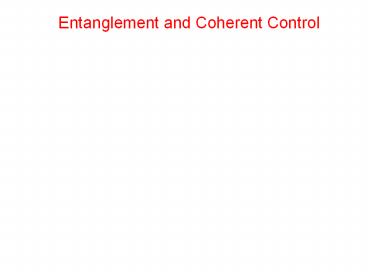Entanglement and Coherent Control - PowerPoint PPT Presentation
1 / 43
Title:
Entanglement and Coherent Control
Description:
We access the same final state using more than one pathway. ... Jiangbin Gong (University of Toronto) John Hepburn (University of British Columbia) ... – PowerPoint PPT presentation
Number of Views:26
Avg rating:3.0/5.0
Title: Entanglement and Coherent Control
1
- Entanglement and Coherent Control
2
- Entanglement and Coherent Control
Coherent Control. objectives Control of future
events. Tools Use quantum interference between
material waves.
3
- Entanglement and Coherent Control
Coherent Control. objectives Control of future
events. Tools Use quantum interference between
material waves. We access the same final state
using more than one pathway. Lacking the which
way information these pathways interfere.
4
- Entanglement and Coherent Control
Coherent Control. objectives Control of future
events. Tools Use quantum interference between
material waves. We access the same final state
using more than one pathway. Lacking the which
way information these pathways interfere.
Interference is not enough. In order to achieve
control we need to tune this interference,
and this is done
with photons.
5
- Bichromatic coherent control (Chem. Phys.
Lett. 126, 541 (1986))
6
- Bichromatic coherent control (Chem. Phys.
Lett. 126, 541 (1986))
A-B-C
7
The two slit analogy the importance of the
relative phase
Screen
Interference pattern
a
b
8
light wave a
9
final matter state
light wave a
10
light wave a
amplitude for absorbing light wave a
11
phase shift
light wave a
amplitude for absorbing light wave a
light wave b
12
phase shift
light wave a
amplitude for absorbing light wave a
light wave b
amplitude for absorbing light wave b
13
phase shift
light wave a
amplitude for absorbing light wave a
interfere
light wave b
amplitude for absorbing light wave b
14
The key to control is that the interference
patterns of different outcomes be shifted in
phase.
A-B C
the screen of relative phases
A B-C
- is favored
15
A-B C
A B-C
- is favored
16
A-B C
A B-C
- is favored
17
A-B C
A B-C
- is favored
18
Generation of DC current in a molecular wire
suspended between two leads
a short pulse
19
Need for entanglement the control of collisions
J. Gong, M. Shapiro, and P. Brumer, J. Chem.
Phys. 118, 2626 (2003)
H2(j0,k0 j2,k2) H2(j0,k0 j2,k2) elastic
E0.4cm_1
E0.04cm_1
-
-
20
21
Can one observer make use of entanglement?
B
22
23
-
n1
24
25
Creation of variable entanglement in polyatomic
molecules
A
B
k2n/2mB
k2n/2mA
26
27
How does B view the uncollapsed wavefunction?
28
29
Control of entanglement
30
31
32
Coherent Control as a Disentanglement
Transformation
33
/
34
35
36
37
A second objective to control of the direction
of electronic motion. The
generation of current without voltage!
pathway a
38
pathway b
pathway a
39
A pictorial representation
p wave
s wave
d wave
40
(forward current)
-
pathway a
pathway b
41
(backward current)
(forward current)
-
-
-
pathway a
-
pathway b
42
E. Dupont, P.B. Corkum, H.C. Liu, M. Buchanan,
and Z.R. Wasilewski, Phys. Rev. Lett. 74, 3596
(1995)
43
Acknowledgments
- Theory
- Ioannis Thanopulos (Univ. of British
Columbia) - Einat Frishman (Univ. of British
Columbia) - Petr Kral (Univ. Illinois
at Chicago) - Dvira Segal
(Weizmann ) - Paul Brumer (University of
Toronto) - Jiangbin Gong (University of
Toronto) - John Hepburn (University of
British Columbia) - Experiment
- Qun Zhang (Weizmann, now at Univ. of British
Columbia) - Alexander Shnitman (Weizmann) , Mark Keil (BGU)

